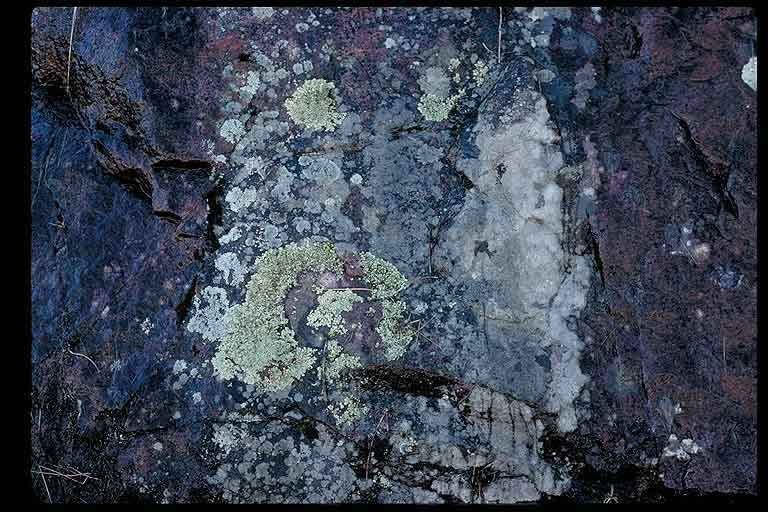Rocks and Stardust : Peter Geldart
Canadian Museum of Nature
"...Only the roots of these mountains remain," writes Peter Geldart, in the accompanying text to the first section, "And the hills seem to follow undulating curves, as if time itself had stopped to carve its name." These are not the sort of words you would expect to find accompanying an exhibition of photographs of rocks.
In Rocks & Stardust curator and photographer Geldart has brought together photographs and words revealing the monumental beauty of the rocks of the Gatineau Park and the Canadian Shield. The smallish enlargements of photographs, shot using a 2 1/4" x 2 1/4" format, are to the last one, exquisite. The detail of lichen, moss, and various other life forms making their way across rock faces sometimes millions of years old is extraordinary.
In addition to the transcriptions of nature's smaller organisms and their relationship with rocks, on a graphic level the images lend themselves well to being transposed on other things. Many, for instance, look like they could just as easily be photographs of stars going nova or galaxies millions of light years away.
As well as his own rather poetic (and wonderfully so) writing, a cosmologist, paleontologist, geologist, astronomer, astrophysicist, and physicist are quoted. Although these last additions lean towards the technical, decidedly dry and even unintelligible to the lay person, they do not douse the sense of timelessness wafting through the Museum of Nature's community gallery. It is further inspired by the music of S. L. Weiss (1686-1750) (Sonatas for Lute) and Philip Glass (Prophecies 1983).
Given that part of the exploration includes an examination of meteorites, there are some technical diagrams and images, pictures courtesy of NASA, some even taken by the Hubble Telescope. Their presence does make sense, although some, along with their textual components, seem a little too dry and technical by comparison with most of the other work.
Even though the presentation is unremarkably traditional—pictures in frames on walls—the combination of lyrical words, stunning imagery and resplendent music create a very relaxing contemplative environment.
Threaded throughout the small text panels, Geldart weaves the story of how our chunk of rock was formed, working in some lyrical aspects. Using photographs taken by various scientists working for the Geological Survey of Canada and elsewhere, the exhibition also explores the nature of ancient rock on earth.
While not all of it is meteoric in origin, the oldest known rock in the world is apparently found in the northern reaches of Canada in Nunavut. In addition to photographic examples, a climate-controlled glass showcase contains a sample. "Oldest Rock 2" dates from 4.05 billion years ago. If any of us live to such a wizened age (hopefully not), let's just hope we all look as good as this bit of boulder does. Unlike us humans, apparently it's the darker veins (not the grey ones) that attest to its venerable antiquity.
Especially for those to whom the word "science" is anathema, the exhibit contains some impeccable examples of the interconnectedness of our un/conscious mind(s) with the natural world. From the marks made by millennia of raindrops, fossils made by creatures millions of years ago, to the traceries left by all manner of flora, they are irrefutable in speaking to the melding of the worlds of art and science. Many of these patterns have been used in the arts in one way or other for centuries.
Displayed on the marble stand it was originally shown on at the 1855 Universal Exposition in Paris, the pièce de resistance of the rock samples in the exhibit has to be the Madoc meteorite. Discovered in 1854 near Madoc, Ontario, and acquired by the Geological Survey the following year, this deep dark brown-black 4.56 billion year old rock is as old as our solar system!
Deeply pock-marked with sections of it glinting with unnamed minerals, since falling into human hands the meteorite has unfortunately suffered further indignities. Originally, 167.5 kilograms, it now weighs 156. It is described as the largest and heaviest single meteorite ever found in Canada.
If Time itself could have an ultimate physical manifestation, surely this is it. If this time of year causes your spirits to swirl into dark waters, this is the piece that will give you some persepective. Looking at this distinguished stone, I couldn't help but wonder what fantastic stories it could tell us if it could speak. (For starters, imagine what a tale of "frequent flyer" points (and "frequent fryer" from entering planetary atmospheres) it would have to tell.)
Altogether as much as it is about rocks and photography, Rocks & Stardust is very much an exhibition about the human condition. All its elements combined make for a rather heady concoction of peace and tranquility and a sense of timeless perseverance—just what we all need after the material excesses of Christmas.
Published by The Ottawa Xpress, 2001
In Rocks & Stardust curator and photographer Geldart has brought together photographs and words revealing the monumental beauty of the rocks of the Gatineau Park and the Canadian Shield. The smallish enlargements of photographs, shot using a 2 1/4" x 2 1/4" format, are to the last one, exquisite. The detail of lichen, moss, and various other life forms making their way across rock faces sometimes millions of years old is extraordinary.
In addition to the transcriptions of nature's smaller organisms and their relationship with rocks, on a graphic level the images lend themselves well to being transposed on other things. Many, for instance, look like they could just as easily be photographs of stars going nova or galaxies millions of light years away.
As well as his own rather poetic (and wonderfully so) writing, a cosmologist, paleontologist, geologist, astronomer, astrophysicist, and physicist are quoted. Although these last additions lean towards the technical, decidedly dry and even unintelligible to the lay person, they do not douse the sense of timelessness wafting through the Museum of Nature's community gallery. It is further inspired by the music of S. L. Weiss (1686-1750) (Sonatas for Lute) and Philip Glass (Prophecies 1983).
Given that part of the exploration includes an examination of meteorites, there are some technical diagrams and images, pictures courtesy of NASA, some even taken by the Hubble Telescope. Their presence does make sense, although some, along with their textual components, seem a little too dry and technical by comparison with most of the other work.
Even though the presentation is unremarkably traditional—pictures in frames on walls—the combination of lyrical words, stunning imagery and resplendent music create a very relaxing contemplative environment.
Threaded throughout the small text panels, Geldart weaves the story of how our chunk of rock was formed, working in some lyrical aspects. Using photographs taken by various scientists working for the Geological Survey of Canada and elsewhere, the exhibition also explores the nature of ancient rock on earth.
While not all of it is meteoric in origin, the oldest known rock in the world is apparently found in the northern reaches of Canada in Nunavut. In addition to photographic examples, a climate-controlled glass showcase contains a sample. "Oldest Rock 2" dates from 4.05 billion years ago. If any of us live to such a wizened age (hopefully not), let's just hope we all look as good as this bit of boulder does. Unlike us humans, apparently it's the darker veins (not the grey ones) that attest to its venerable antiquity.
Especially for those to whom the word "science" is anathema, the exhibit contains some impeccable examples of the interconnectedness of our un/conscious mind(s) with the natural world. From the marks made by millennia of raindrops, fossils made by creatures millions of years ago, to the traceries left by all manner of flora, they are irrefutable in speaking to the melding of the worlds of art and science. Many of these patterns have been used in the arts in one way or other for centuries.
Displayed on the marble stand it was originally shown on at the 1855 Universal Exposition in Paris, the pièce de resistance of the rock samples in the exhibit has to be the Madoc meteorite. Discovered in 1854 near Madoc, Ontario, and acquired by the Geological Survey the following year, this deep dark brown-black 4.56 billion year old rock is as old as our solar system!
Deeply pock-marked with sections of it glinting with unnamed minerals, since falling into human hands the meteorite has unfortunately suffered further indignities. Originally, 167.5 kilograms, it now weighs 156. It is described as the largest and heaviest single meteorite ever found in Canada.
If Time itself could have an ultimate physical manifestation, surely this is it. If this time of year causes your spirits to swirl into dark waters, this is the piece that will give you some persepective. Looking at this distinguished stone, I couldn't help but wonder what fantastic stories it could tell us if it could speak. (For starters, imagine what a tale of "frequent flyer" points (and "frequent fryer" from entering planetary atmospheres) it would have to tell.)
Altogether as much as it is about rocks and photography, Rocks & Stardust is very much an exhibition about the human condition. All its elements combined make for a rather heady concoction of peace and tranquility and a sense of timeless perseverance—just what we all need after the material excesses of Christmas.
Published by The Ottawa Xpress, 2001


